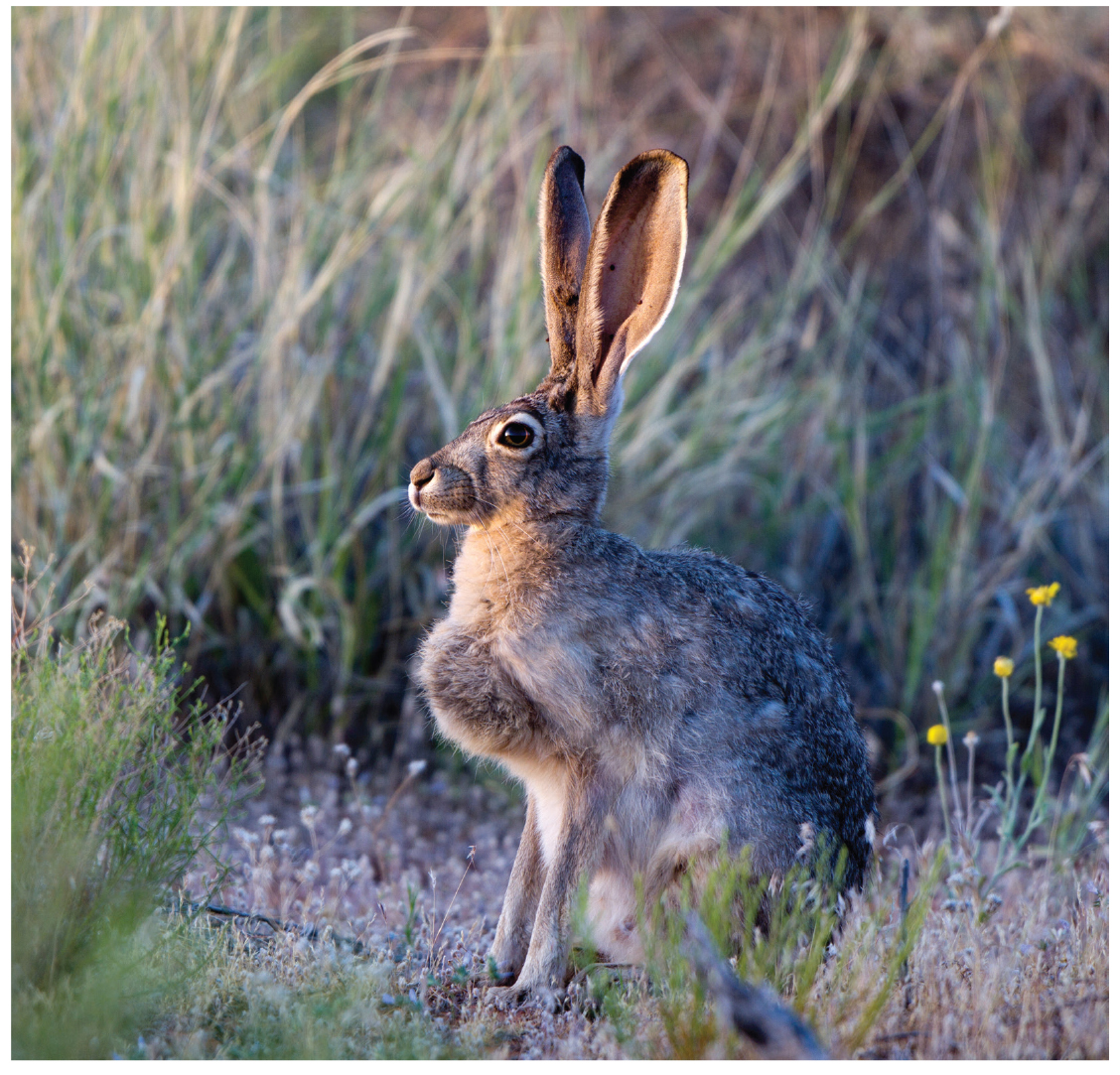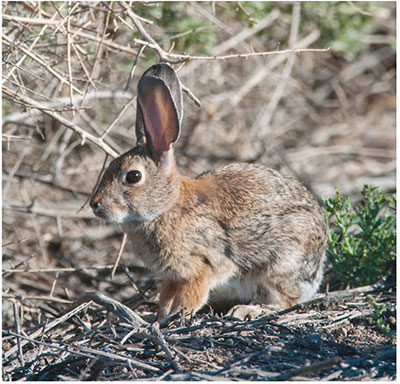Guide L-210
Revised by Samuel T. Smallidge
College of Agricultural, Consumer and Environmental Sciences, New Mexico State University
Author: Extension Wildlife Specialist, Department of Extension Animal Sciences and Natural Resources, New Mexico State University. (Print Friendly PDF)
Identification
New Mexico is home to two major species of jackrabbits and three cottontail species. The black-tailed jackrabbit (Lepus californicus) occurs throughout the state, except in the northeast quarter where the white-tailed jackrabbit (Lepus townsendii) is found. The desert cottontail (Sylvilagus audubonii) occurs throughout the state, while the mountain cottontail (Sylvilagus nuttallii) occurs primarily in northern New Mexico. Eastern cottontails (Sylvilagus floridanus) inhabit most of the state, with the exception of the northwest quarter.
The white-tailed jackrabbit is the largest, with a head and body length of 18 to 20 inches and a weight of 5 to 10 pounds. It is brownish gray in summer and white or pale gray in winter. The tail is also white. The black-tailed jackrabbit is somewhat smaller, weighing only 3 to 7 pounds. It has a grayish brown body, large black-tipped ears, and a black streak on the top of its tail (Figure 1).
The eastern cottontail is 14 to 17 inches in length and weighs between 2 and 4 pounds. The brownish or grayish ears are 2.5 to 3 inches long. The tail is cottony white. The desert cottontail is smaller (12 to 15 inches in length) and has longer ears (3 to 4 inches long). The body is pale gray washed with yellow (Figure 2). The mountain cottontail is similar to the eastern cottontail, but somewhat paler. The mountain cottontail also has shorter ears (about 2.5 inches long) compared to the desert cottontail.
Figure 1. Black-tailed jackrabbit.
Martha Marks | Dreamstime.com
Habitat
Both the white-tailed and black-tailed jackrabbits prefer semi-open, grassy or sagebrush plains and sparsely vegetated deserts. The eastern cottontail prefers heavy brush, forest strips near open areas, and weed patches. The mountain cottontail is often associated with thickets, sagebrush, and cliffs, while the desert cottontail prefers open plains, foothills, and low valleys of the arid Southwest.
Food Habits
Food sources for jackrabbits and cottontails in New Mexico vary according to the alternating dry and rainy seasons. Following rainy periods, forbs and perennial grasses grow new leaves and become more abundant in their diet. At the same time, the amount of mesquite, cactus, and woody vegetation in their diet decreases to almost nothing. During arid periods, grass dries up and is eaten less often, and the percentage of mesquite and woody vegetation in their diet increases.
Rainfall’s effect is not as obvious in northern New Mexico, but it continues to increase rabbit preference for forbs and grasses. Rabbits feed mostly on grasses and other green vegetation in summer. They add buds, bark, and small twigs in winter.
Rabbits in all areas prefer green vegetation when available. Agricultural crops are especially attractive when natural vegetation is low in moisture content. When green vegetation is not available, rabbits can damage ornamental and fruit trees by browsing or girdling.
General Biology
Jackrabbits and cottontails are born with lots of fur and the ability to move about. Jackrabbits prepare little or no nest, although the young are kept hidden for three to four days after birth. Female cottontails build a nest approximately the size of a softball and line it with fur from their bellies. Female jackrabbits and cottontails can produce up to four litters per year of two to eight young per litter. Reproductive rates may vary from year to year depending on environmental conditions.
Where food and shelter are both available in one place, jackrabbits only move around locally. When food and shelter are separated, a morning and evening movement can be observed. Daily movements of 1 or 2 miles each way are fairly common for jackrabbits. In dry seasons, 10-mile round trips from desert to alfalfa fields have been reported. Cottontails, however, spend their lives in smaller areas, generally of 10 acres or less.
Figure 2. Desert cottontail.
Paul Sparks | Dreamstime.com
Damage
Significant damage occurs when concentrations of rabbits are attracted to orchards, gardens, ornamentals, or agricultural areas. High rabbit populations can also damage range vegetation.
Most damage to gardens, landscapes, or agricultural areas occurs in areas adjacent to rangeland normally used by rabbits. Damage may be temporary and usually occurs when natural vegetation is dry. Green vegetation can be damaged severely during these dry periods.
Rangeland overbrowsing and overgrazing can occur any time rabbit numbers are high. Jackrabbits consume 1/2 to 1 pound of green vegetation each day. It has been estimated that eight jackrabbits eat as much as one sheep, and 41 jackrabbits eat as much as one cow. In some areas heavily infested with jackrabbits, numbers have been estimated as high as 400 per square mile, extending over several hundred square miles. Range damage can be severe in such situations, especially in areas where vegetation productivity is low.
Legal Status
Jackrabbits and cottontails are considered nongame animals in New Mexico and are not protected by state game laws.
The white-sided jackrabbit (Lepus callotis) occurs in the southwestern corner of New Mexico and is listed by the state of New Mexico as a threatened species. While it looks similar to the black-tailed jackrabbit, the white-sided jackrabbit is stockier and conspicuously white along the sides of its body. If you are experiencing problems from this species, please contact New Mexico Department of Game and Fish for assistance.
Damage Prevention and Control Methods
Exclusion
Exclusion is accomplished most often by fences and gates installed around the area to be protected. Exclusion by fencing is desirable for small areas of high-value crops like vegetable gardens, but is usually impractical and too expensive for larger acreages. However, when considering cost, remember that damage to high-value crops can mean big losses. Also, the cost of fencing can be spread over several years.
For fence construction, use woven wire or poultry netting of a mesh not greater than 1 inch. To exclude jackrabbits, the height should be 30 to 36 inches, while 18 to 24 inches is sufficient for cottontails. The wire’s bottom edge should be staked to the ground or buried several inches deep to prevent rabbits from burrowing under the fence.
Reusable fence panels also may be constructed easily to protect gardens. These 18- to 36-inch-high panels (depending on species) exclude foraging rabbits while allowing gardeners easy access. Panel frames can be constructed with 2 × 2 inch lumber. A 1-inch mesh galvanized wire, such as poultry netting (18 to 36 inches high), is fastened to one side of the frame. Panels can be made in various lengths to match the size of the garden. Lightweight posts, such as electric fence posts, are sufficient for support. One post should be placed in each corner and at each junction of panels. Panels can be fastened to the posts using malleable wire.
Using individual protectors to guard the trunks of young trees or vines is another form of exclusion. The best option is cylinders made from woven wire netting. Poultry netting of one-half inch mesh in 20 gauge strips, 12 to 18 inches wide, can be formed into cylinders around trees. For adequate protection, these cylinders should be braced away from the trunk to prevent rabbits from pressing them against the trees and gnawing through them.
Commercially available tree protectors include aluminum, nylon mesh wrapping, and polypropylene plastic. Aluminum foil and even ordinary plastic wraps have worked effectively around the trunks of small trees.
Trapping
Along with exclusion, using wooden cage traps is probably the most practical means of controlling problem cottontails. However, using wooden cage traps is not effective for jackrabbits because they are reluctant to enter a trap or dark enclosure. In addition, live trapping is less effective during the summer months because abundant vegetation makes it more difficult to attract them. Therefore, exclusion is more feasible during the summer.
A live trap can be constructed of wood using a few simple tools (Figure 3). Place traps in areas with a lot of rabbit activity, as evidenced by tracks and gnawing on woody plants. Use live traps that measure 6 × 6 × 24 inches. Also, covering commercially available wire-mesh live traps with tarpaper (available where roofing supplies are sold) and securing with annealed steel wire may be an effective alternative for trapping cottontails. Uncovered wire-mesh live traps are better suited for trapping jackrabbits. Lettuce, apples, carrots, and corn are all good baits. Always place the bait so the rabbit can see it, with some at the outside entrance and the rest inside, beyond the trigger at the back. Be sure to check the traps daily.
Materials list:
All box parts can be built from a single 1 × 8 inch board 10 ft long (see Figure 3).
Lever—3/4 × 3/4 × 18 1/2 inch
Pivot—3/4 × 3/4 × 7 1/2 inch
Guides—3/4 × 3/4 inch × height of side (make 4)
Trigger—3/8 or 1/2 inch dowel 11 inches long (see trigger detail in Figure 3)
Figure 3. Dimension for constructing a rabbit live trap (Henderson and Lee, 1992).
Repellents
Rabbit repellents are often unsatisfactory for protecting plants from rabbits, especially in the long term. However, chemical repellents may provide some temporary protection from rabbit damage to trees, vines, or farm and garden crops.
Repellents can be classified as area (odor) or contact repellents (taste). Area repellents, which include bloodmeal, ammonium soaps of higher fatty acids (Hinder), bone tar oil (Magic Circle Rabbit Repellent), and other similar repellents, are used during the growing season. Ammonium soaps of higher fatty acids are applied more frequently, especially after rains.
Contact repellents are applied during the growing and dormant seasons. Apply contact repellents, such as Thiram, Ropel, and Millers Hot Sauce, directly to the plants because rabbits are repelled by the taste. Contact repellents applied during the growing season must be reapplied as new growth emerges. Repellents can be brushed, sprayed, or dipped onto the plants and should be applied 18 to 36 inches (depending on the rabbit species) above the expected snow depth.
Generally, garden crops are damaged in urban situations. Normally, repellents are not designed or recommended for use on plants grown for human consumption. In addition, many repellents offer only temporary protection and must be renewed too often to justify their use.
Repellents must be used according to label instructions. Carefully follow directions on dilution, application rates, and number of repeat treatments permitted. Also, follow label directions closely when handling and storing repellents.
Cultural Methods
In areas where rabbit damage is likely to occur, crops like alfalfa, young cotton plants, lettuce, and young grape vines are often heavily damaged. Crops like corn are usually not damaged once they grow beyond the seedling stage. Where possible, avoid planting preferred crops that are likely to be damaged.
High rabbit numbers in residential areas may result from timing and use of adjacent rangelands by domestic or wild ungulates. For example, jackrabbits may be abundant in residential areas in response to herbaceous vegetation availability resulting from domestic or wild ungulate use. Jackrabbits, like many rodents, prefer open rangelands but will seek out forage where available. Thus, control programs accompanied by adjustments in grazing practices may be necessary for long-term relief.
Other Methods
Frightening devices, including electromagnetic and ultrasonic units, have not been proven effective in controlling rabbits. There are also no poisons or fumigants registered for use on rabbits in New Mexico.
Shooting is a quick, easy, and effective control method—but make sure local firearms laws allow it and that it is done safely. Persistence is required if shooting is the only technique used. Removing rabbits in one year never guarantees that the population will be low the next year (this also is true for trapping).
Encouraging the rabbit’s natural enemies may aid in reducing rabbit damage. Hawks, owls, eagles, coyotes, foxes, bobcats, and snakes all help the farmer, gardener, and homeowner control rabbits.
Acknowledgments
Much of the information in this publication was adapted from:
Craven, S.R. 1994. Cottontail rabbits. In S.E. Hygnstrom, R.M. Timm, and G.E. Larson (Eds.), Prevention and control of wildlife damage. University of Nebraska-Lincoln.
Henderson, F.R., and C. Lee. 1992. Cottontail rabbits: Urban wildlife damage control [L-858]. Manhattan: Kansas State University Cooperative Extension Service.
Knight, J.E. 1988. Controlling jackrabbits in New Mexico [Guide L-208]. Las Cruces: New Mexico State University Cooperative Extension Service.
Knight, J.E. 1994. Jackrabbits. In S.E. Hygnstrom, R.M. Timm, and G.E. Larson (Eds.), Prevention and control of wildlife damage. University of Nebraska-Lincoln.
For Further Reading
L-211: Controlling Nuisance Woodpeckers in New Mexico
https://pubs.nmsu.edu/_l/L211/index.html
L-212: Controlling Nuisance Birds in New Mexico
https://pubs.nmsu.edu/_l/L212/index.html
CR-574: Controlling Rock Squirrel Damage in New Mexico
https://pubs.nmsu.edu/_circulars/CR574/index.html
Original authors: Jon Boren, Extension Wildlife Specialist; and Brian J. Hurd, Extension Research Specialist.

Samuel T. Smallidge is the Extension Wildlife Specialist at New Mexico State University. He has degrees in wildlife and range management. His Extension program focuses on wildlife damage management, wildlife enterprises, and wildlife ecology and management education for youth and adults.
To find more resources for your business, home, or family, visit the College of Agricultural, Consumer and Environmental Sciences on the World Wide Web at pubs.nmsu.edu.
Contents of publications may be freely reproduced for educational purposes. All other rights reserved. For permission to use publications for other purposes, contact pubs@nmsu.edu or the authors listed on the publication.
New Mexico State University is an equal opportunity/affirmative action employer and educator. NMSU and the U.S. Department of Agriculture cooperating.
Revised December 2022 Las Cruces, NM





